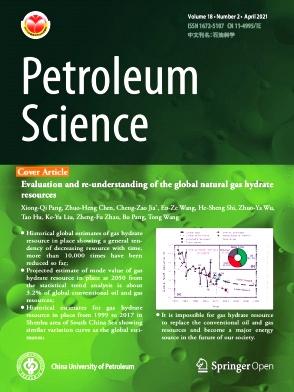Deciphering origins of hydrocarbon deposits by means of intramolecular carbon isotopes of propane adsorbed on sediments
IF 6
1区 工程技术
Q2 ENERGY & FUELS
引用次数: 0
Abstract
Hydrocarbons are one of the important fluids within the Earth's crust, and different biotic and abitoic processes can generate hydrocarbon during geological periods. Tracing the sources and sinks of hydrocarbons can help us better understand the carbon cycle of the earth. In this study, an improved approach of adsorbed hydrocarbons extraction from sediments was established. The improved thermal desorption approach, compound-specific isotope analysis and position-specific isotope analysis were integrated to investigate the molecular and intramolecular isotope fractionation between trace hydrocarbon gases within sediments and geological hydrocarbon deposits. The isotopic compositions of the terminal position carbon of propane (δ13Cterminal) serves as a correlation indicator between trace hydrocarbon gases within sediments and geological hydrocarbon deposits. The tight sandstone gas from the Turpan-Hami Basin is a first case study for the application of this novel method to trace hydrocarbon origins. The results showed that the hydrocarbons in the tight sandstone gases in the study area most likely originated from humic organic matter (type III kerogen) at an early mature stage. δ13Cterminal values of the thermally desorbed propane gases from different source rocks were distinguishable and the values of the tight sandstone gases significantly overlap with those of the Lower Jurassic Sangonghe source rocks, suggesting their genetic relationship. Overall, the results provided novel position-specific carbon isotopic constraints on origins of hydrocarbons.
求助全文
约1分钟内获得全文
求助全文
来源期刊

Petroleum Science
地学-地球化学与地球物理
CiteScore
7.70
自引率
16.10%
发文量
311
审稿时长
63 days
期刊介绍:
Petroleum Science is the only English journal in China on petroleum science and technology that is intended for professionals engaged in petroleum science research and technical applications all over the world, as well as the managerial personnel of oil companies. It covers petroleum geology, petroleum geophysics, petroleum engineering, petrochemistry & chemical engineering, petroleum mechanics, and economic management. It aims to introduce the latest results in oil industry research in China, promote cooperation in petroleum science research between China and the rest of the world, and build a bridge for scientific communication between China and the world.
 求助内容:
求助内容: 应助结果提醒方式:
应助结果提醒方式:


